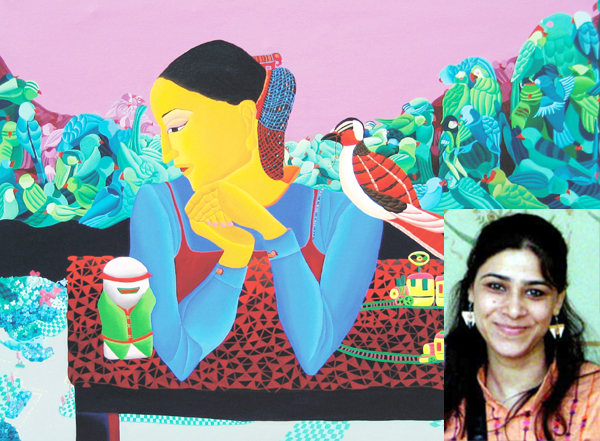Lalit Gupta
Making her place at the mast of contemporary Indian art scene, the young Dogra woman painter Sunanda Khajuria, is one such gifted artist who has done Jammu proud and especially her native village Painthal near Katra.
Her paintings in which she paints a world of fantasy, nostalgia and utopias thus reiterating the gifts which empower us to dress up our otherwise drab environments with shimmering lamps of dreams and recollections-have won accolades as brilliant creative expressions that seem to unlock certain truths that are within and part of most of us.
Sunanda Khajuria’s paintings are testimony to the fact that even in a pragmatic world sworn to factual truth, the assumption that fantasies are no longer necessary for discovering our true potential does not hold true. Though unreal, dreams are life enhancing, inspiring courage.
Born in a quaint village of Painthal and brought up in Jammu, Sunanda recognized and developed her passion for painting from an early age, where she began by transforming day to day experiences into pictorial narratives. Having graduated from the Institute of Music & Fine Arts, Jammu, she subsequently shifted to New Delhi to pursue her masters at the Delhi College of Fine Arts. After completing her masters in fine arts, she was selected for various residency programmes overseas and has travelled to Australia, Tanzania, Italy and Russia, Hong Kong.
Her latest sojourn was China in connection with residency programs at the Red Gate Art Gallery in Beijing, China. One who was awarded 2010-12, Scholarship for Advance Research on Chinese Art, she has also the honour of receiving awards from AIFACS, New Delhi, National Scholarship, Ministry of H.R.D and Lalit Kala Research Grant.
Today a much sought after women artist, the characteristic feature of her paintings is that while drawing heavily from beliefs and anecdotes that have dotted her past, she meticulously picked up motifs from memory, impregnating them with inferences from the present in a glorious coalition of past and present, rural and urban. Metaphors of the river, the mountains, the moon, and the number of three, are leitmotifs of a past that have re-surfaced only after having receded far into distant memory, and getting compartmentalised as irretrievable.
Wanting to see the world afresh she discards all the accepted notions and prejudices about flesh being pink and apples yellow or red and creates a pictorial world full of symbolic overtones. Whether critical or introspective, she delves into personal memory, transforming them in her work, herself the protagonist, frequently the optical centre of a painting. Exploring possibilities of forging links via the visual cultures of countries is to her a thrilling artistic challenge.
Her works marked with bright colours and followed by the pictorial daring in her manner of composing are ornate and reminiscent of traditional art, are replete with a sense of celebration in their very act of existence.
Sunanda Khajuria sums up the process of creative journey as following, “With systematic training in art, over the years I have become more interested in understanding the emotional and psychological states of human nature and explore the possibilities of its visualization in my work.
This process generally begins with taking a queue from the mundane and trying to look into nature and constitution of human situations, desires and aspirations. As a culmination of this complex and extend process, I understand, that my work ultimately attains a reality of its own. A reality that is a sum total of what I see, react to, think perceive, memorize, personalize and feel like externalizing as a visible manifestation.However, with whichever the resource I draw my imagination from or whatever the reasons stimulating me to start and evolve my work, I always try to stay within the parameters of decent, positive and socially acceptable aesthetics. I strongly believe that in the name of creativity one does not drift into an attitude of selfish individualism that seeks only private joy”.


